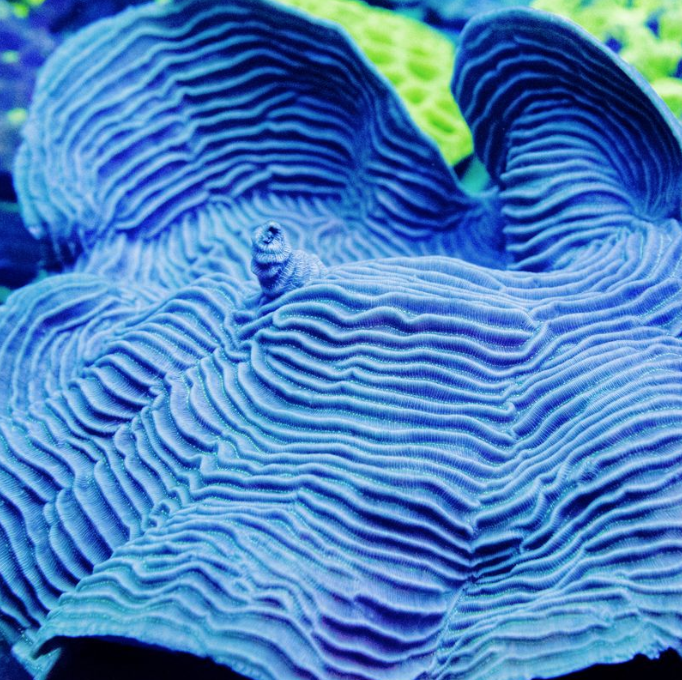Pachyseris is a name you might not be abundantly familiar with, and I don’t blame you. Like the majority of other aquarists, if your only experience with corals is through the aquarium hobby (which there is absolutely nothing wrong with), this is a coral that you’ve likely never seen for sale before and if you have, might have overlooked.
Broadly speaking, Pachyseris can seem a bit underwhelming to those who are not familiar with their intricacies. Thus, in the next several paragraphs, I will attempt to convince you the reader, that Pachyseris are quite possibly some of the coolest stony corals in existence.
For starters, the name Pachyseris itself is an interesting one. The name stems from two Greek works “pachys” and “seris”. Put together, this translates literally to “thick lettuce”. This odd name refers to the often thick ridge-like structures called collines found in corals from the family Agariciidae and Pachyseridae (more on this later).
Some sources also designate Pachyseris by the colloquial name of “elephant skin corals” due to their appearance which resembles the wrinkly, folded skin of an elephant’s flanks. This name too bears some merit, as elephants were once included in the now-obsolete mammalian order Pachydermata, a group whose name means “rough skin” and included megafaunal animals unified by said trait including elephants, rhinoceroses, and hippopotamuses.
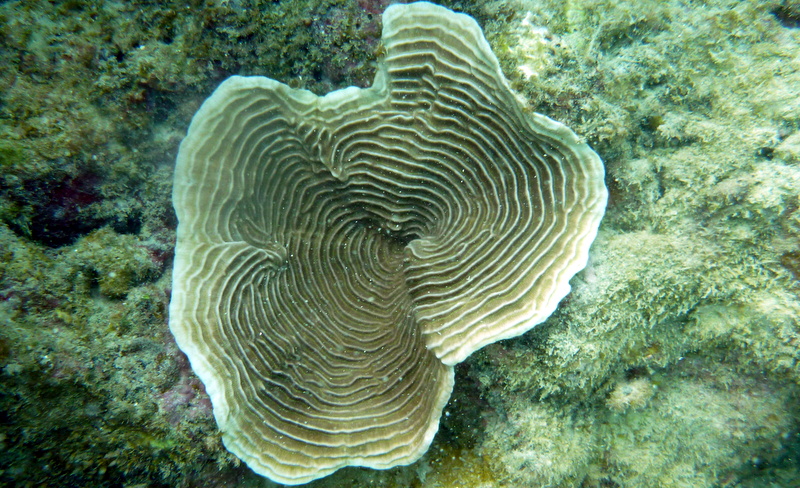
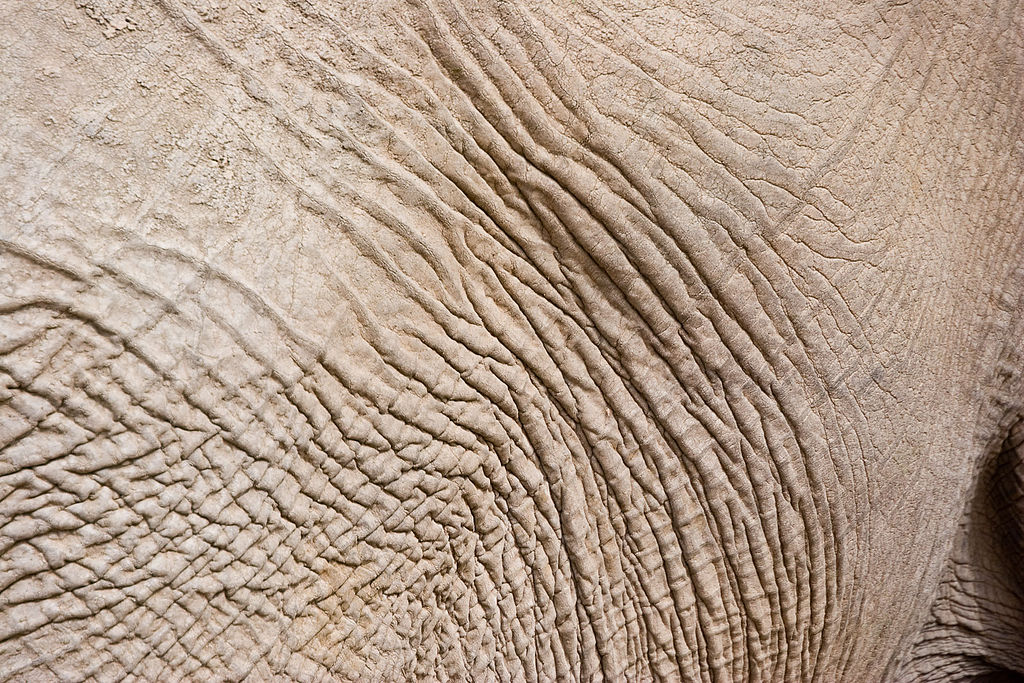
With a little imagination, it’s easy to see how Pachyseris got their common name of “elephant skin corals”.
In the wild, Pachyseris are fairly abundant throughout the Indo-Pacific. Corals from this genus span the entire range of depths where photosynthetic corals are physically capable of existing, from the harsh, sun-baked intertidal to dark, mesophotic reef slopes over a hundred feet below the waves.
However, Pachyseris tend to favor dimly lit environments in deep waters where their incredibly slow growth rate is not a competitive disadvantage when compared to more prolific reef-building stony corals. In these habitats, Pachyseris form vast fields of whorling colonies that can stretch for miles like the one discovered off the island of Tahiti in 2022.
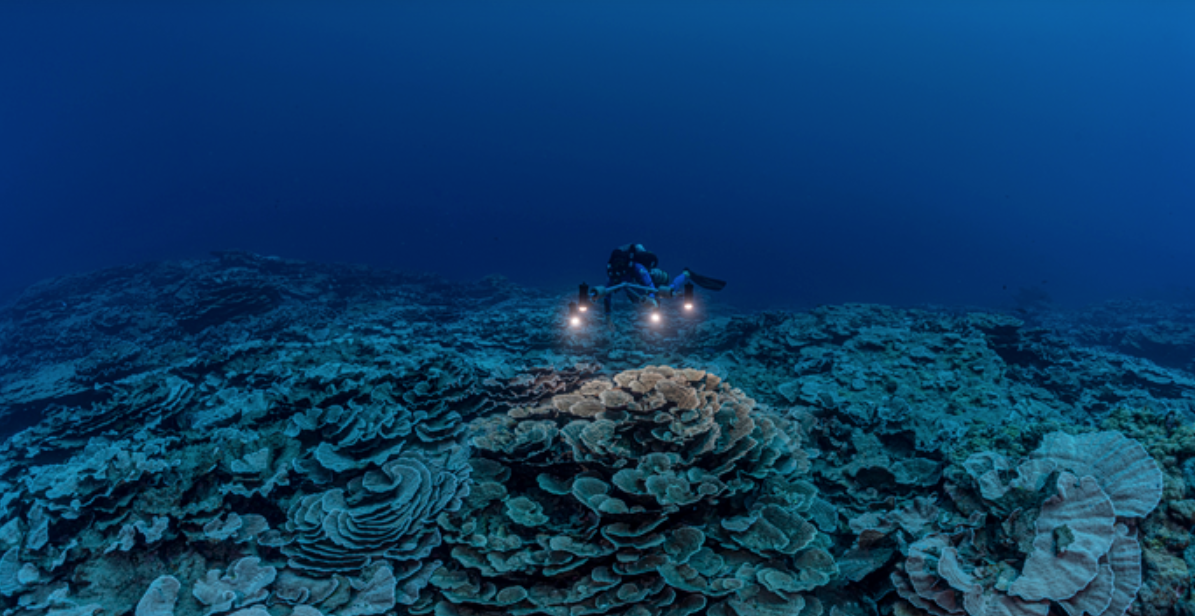
The genus Pachyseris currently contains roughly half a dozen nominal species, but as few as four species may truly be valid. All species of Pachyseris are easily recognizable by the presence of ridge-like structures called collines (or more specifically, carinae), giving the surface of these corals a distinctive topography of alternating peaks and valleys. These carinae are often arranged in parallel rows, eventually forming concentric rings in foliose colonies. Between the peaks of adjacent carinae, lie rows of tiny mouths, indicated by subtle fluorescence in wild specimens.
The Morphological Marvel of Pachyseris
Colonies of Pachyseris are generally composed of thin plates called laminae that develop into frond-like, whorling, or plating growth forms depending on the species and the environment it grows in. The majority of Pachyseris species are unifacial, meaning that their carinae only grow on one side of each lamina. Colonies of Pachyseris rugosa and P. gemmae (which may be a junior synonym of P. rugosa) can exhibit vertical fronds with bifacial laminae.
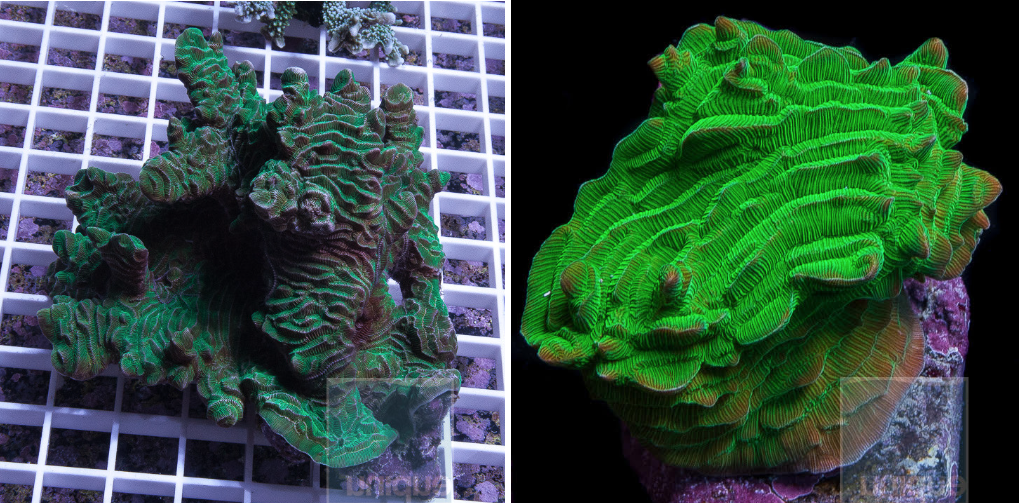
A more fine-scale analysis of any Pachyseris would reveal intricate structures that shed light on an incredible degree of morphological adaptations. Keep in mind that Pachyseris can be found in just about every type of reef habitat, meaning that their morphology must be fairly plastic to contend with the wide range of environmental conditions that they may encounter.
One of the most noticeable adaptations seen in Pachyseris is the variation in carinae height. In highly variable species like Pachyseris speciosa, the height of a colony’s carinae is highly dependent on the amount of flow it receives in its environment. In exposed environments characterized by higher flow, these carinae are well-developed and fairly tall. These structures produce perturbations in turbulent flow, causing particulate matter to fall out of the water column and settle on the coral’s surface.
Conversely, in low-flow environments, these carinae flatten out, almost to the point where they are level with the rest of the surrounding coenosteum. Without heavy surge, the corals devote fewer resources toward calcifying their carinae as there is less need to interrupt localized water flow for prey capture.
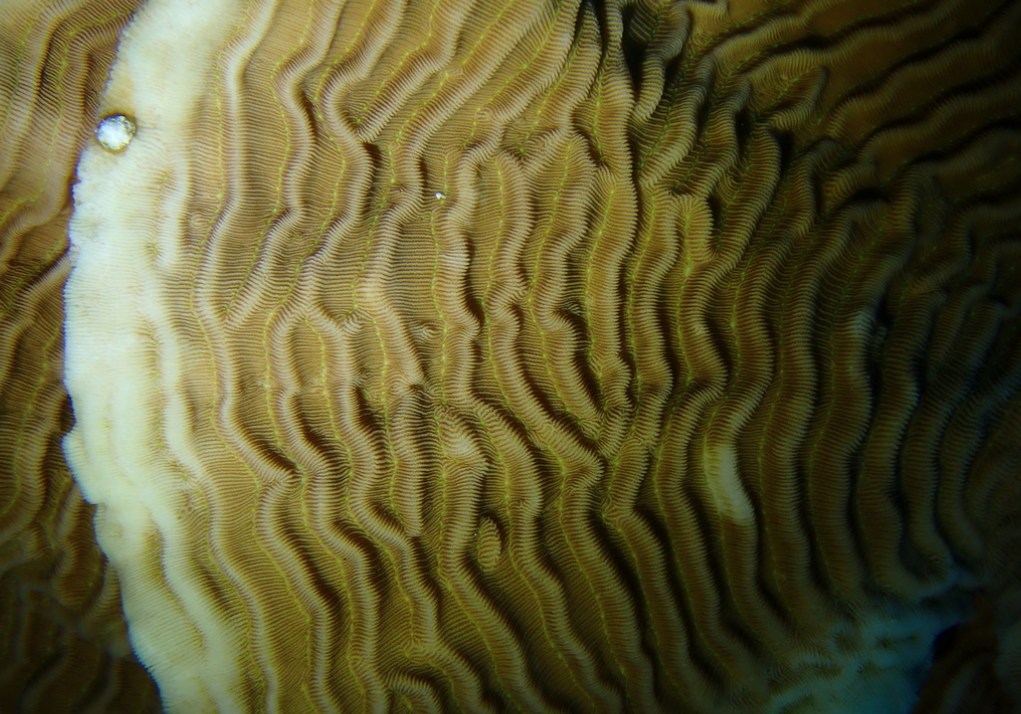
A Unique Approach to Prey Capture
Pachyseris utilize the fundamentals of fluid dynamics to channel water flow across their corallum where the flow is broken up by the rough surface of their carinae. As particulate matter falls out of suspension, it settles onto the coral’s surface and becomes engulfed in mucus produced by mucocyte cells embedded within the underlying tissue.
Just beneath this are tiny skeletal elements called septocostae which cover the entire surface of the coral’s skeleton. These can just barely be seen by the naked eye, and appear as rows of thin zig-zagging lines that run perpendicularly to the direction of the carinae.
Each one of these septocostae bears millions of microscopic hairs called cilia that beat in unidirectional synchrony to brush particulate-laden mucus into the valleys between carinae where the polyp’s mouths reside. Particulates that are not consumed (sand, inorganic detritus, etc) fall down the sloping laminae and collect in the center of an often bowl-like growth form where they won’t impede the growing edge of the coral. Very few corals, if any, have such highly efficient morphologies.
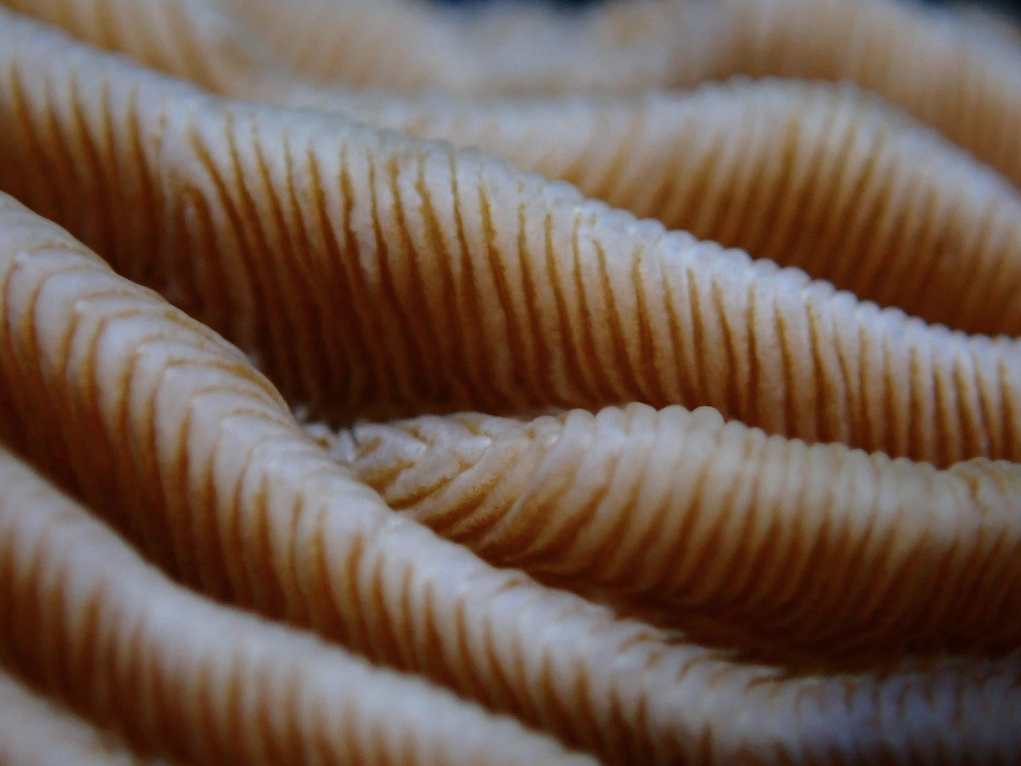
However, unlike every other type of stony coral, Pachyseris do not possess stinging tentacles for prey capture. None of the nearly 3,000 other stony corals have this trait, with the next closest example being an obscure stony coral called Coeloseris mayeri which has highly reduced (but still present) tentacles.
Given that tentacles serve a critical role in prey capture, it would seem likely that Pachyseris spp. are poorly suited for life as partial heterotrophs. Despite their lack of tentacles, Pachyseris are not as ill-equipped as one might expect. Instead, the entire surface of the coral is covered with nematocyst-stinging cells embedded within the coenosarc, effectively turning the entire coral into a single prey-capture surface.
Ecophysiology at the Extremes
Pachyseris corals even exhibit specialized adaptations at a microscopic level. Each one of the thousands of septocostae covering the skeleton of the coral has nanoscopic flanges called menianes that can only be seen under high-power magnification. Given their size, these tiny microstructural characteristics may seem insignificant to us, but in the incredibly low light conditions of mesophotic reefs, these menianes maximize the available photosynthetic surface area and can make the difference between life and death for Pachyseris corals.
On the opposite end of the spectrum, the urbanized shallow-water reefs of Singapore are largely dominated by Pachyseris corals. Despite their depth, many of these reefs are characterized by chronically low light levels attributed to high sediment deposition and turbidity, a textbook symptom of nearshore urbanization.
The sediment that flows out to sea would typically choke out other stony corals by decreasing the light penetrance of the water column, or by smothering the coral to the point of death via physical perturbation and dysbiotic invasion. In such austere environments, stony corals would typically not be expected to survive, yet still Pachyseris persists in spite of it all.
The ability of Pachyseris to withstand both bright and dim environments is largely influenced by their ability to “shuffle” their microbiome. While the community composition of Symbiodinaceae endosymbionts is known to vary in all coral species depending on geography, depth, and light availability, Pachyseris seems to be particularly adept at this.
Each type of endosymbiotic dinoflagellate has a particular niche for host specificity, thermal tolerance, and irradiance. In most reefs, Pachyseris endosymbiont communities are dominated by Clade-C dinoflagellates (Cladocopium spp.) which are considered to be the most common type of “zooxanthellae” in stony corals.
However, in heavily sedimented reefs with low light availability, these communities are dominated by Clade-D dinoflagellates (Durusdinium spp.) which are specialists that thrive in hot, turbid waters. The ability to shift from one type of endosymbiont to another is likely a major contributing factor as to why Pachyseris can survive in such a wide array of habitats.
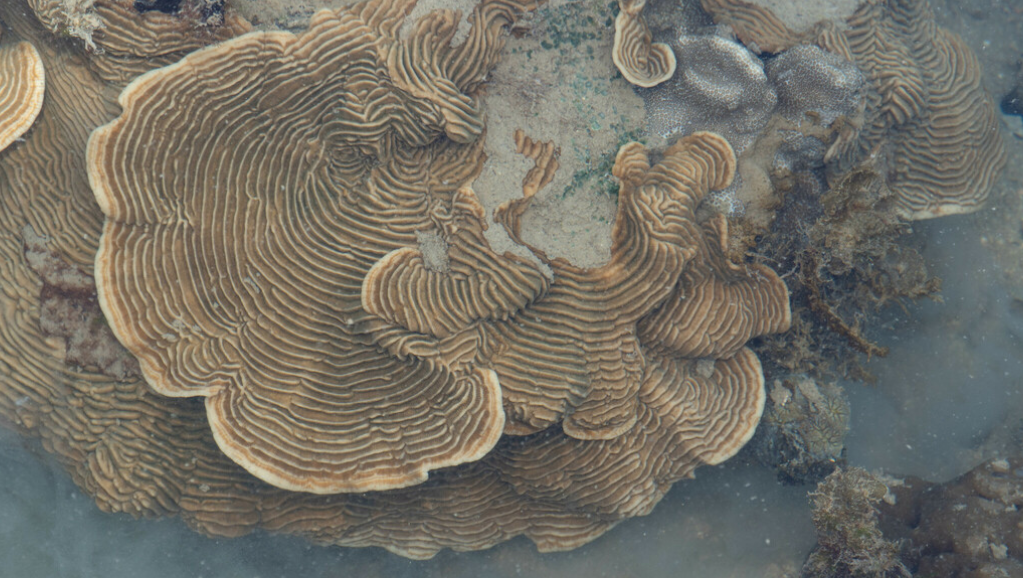
Pachyseris in the Aquarium
As they color up, Pachyseris almost always adopt some shade of green or brown. Occasionally, a specimen with pinkish hues may be offered for sale, but nevertheless, Pachyseris are generally unremarkably colored. A sizeable amount of Pachyseris that can be found on retail sites are also likely misidentified Leptoseris frags, albeit a different species than the typical Leptoseris species found in the hobby (Leptoseris mycetoseroides).
To ascertain the identity of your coral, the best trait to look for is the presence of the distinctive carinae seen in almost all Pachyseris species. These should be visible (or at least parts of them should be visible) even on the smallest of frags. Of the Pachyseris that do make it into the aquarium trade, the majority are P. speciosa. Pachyseris rugosa/gemmae also trickle into circulation at a much lower rate. The other species of the genus are more or less never farmed, collected, or otherwise seen by hobbyists.
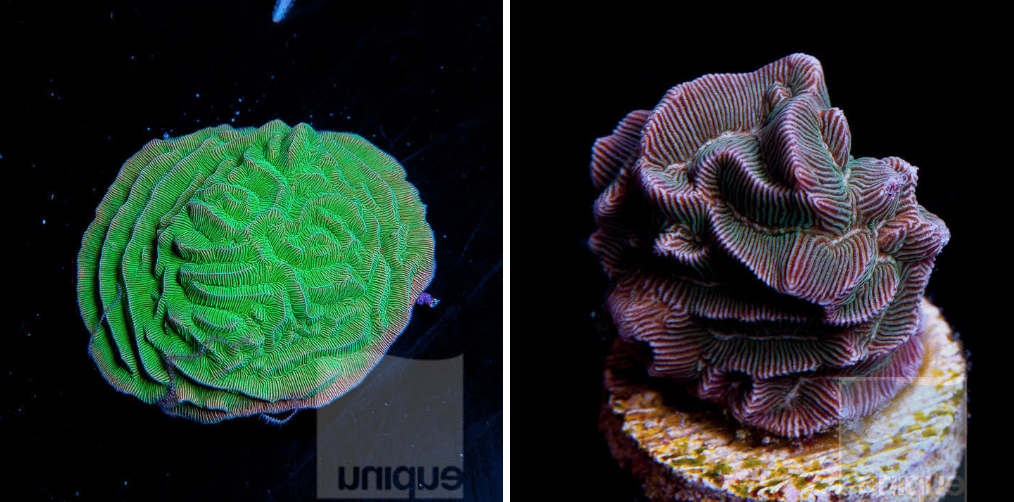
A Footnote in Taxonomy
Despite the seemingly clear physical similarities to corals from the family Agariciidae (like Leptoseris and Agaricia), taxonomists found that Pachyseris and Coeloseris form a complex clade based on genetic data and are more closely related to corals of the family Euphyllidae (Euphyllia, Fimbriaphyllia, Galaxea, etc) rather than those of Agariciidae.
However, while Coeloseris nests nicely within the family Euphyllidae as a sister taxa to Fimbriaphyllia, Pachyseris is a little more estranged. Pachyseris spp. collectively form a distinct subclade within the aforementioned “complex clade” and had for some time been considered “incertae sedis” (Latin for “uncertain placement”) at the family level. Because of this distinct phylogenetic position, Pachyseris was ultimately moved out of Agariciidae and into its own family called Pachyseridae.
In my opinion, a group of corals deemed so unique that they deserve placement in their own family, are special enough to belong in any reef tank. However, given the incredibly slow growth rates of most Pachyseris species in situ, it would be wise to only source aquacultured frags to minimize the potential for overcollection. But if you’re looking for a true oddball stony coral that can withstand almost any conditions you put it in, consider a Pachyseris.
References
Feldman, B., Afiq-Rosli, L., Simon-Blecher, N., Bollati, E., Wainwright, B. J., Bongaerts, P., Huang, D., & Levy, O. (2021). Distinct lineages and population genomic structure of the coral Pachyseris speciosa in the small Equatorial Reef System of Singapore. Coral Reefs, 41(3), 575–585. https://doi.org/10.1007/s00338-021-02160-4
Jain, S. S., Afiq-Rosli, L., Feldman, B., Kunning, I., Levy, O., Mana, R. R., Wainwright, B. J., & Huang, D. (2021). Endosymbiont communities in Pachyseris speciosa highlight geographical and methodological variations. Frontiers in Marine Science, 8. https://doi.org/10.3389/fmars.2021.759744
Lawn, I. D., & McFarlane, I. D. (1991). The physiological control of feeding in corals: A Review. Coelenterate Biology: Recent Research on Cnidaria and Ctenophora, 595–598. https://doi.org/10.1007/978-94-011-3240-4_83
Quek, Z. B. R., Jain, S. S., Richards, Z. T., Arrigoni, R., Benzoni, F., Hoeksema, B. W., Carvajal, J. I., Wilson, N. G., Baird, A. H., Kitahara, M. V., Seiblitz, I. G. L., Vaga, C. F., & Huang, D. (2023). A hybrid-capture approach to reconstruct the phylogeny of Scleractinia (cnidaria: Hexacorallia). Molecular Phylogenetics and Evolution, 186, 107867. https://doi.org/10.1016/j.ympev.2023.107867
Terraneo, T. I., Berumen, M. L., Arrigoni, R., Waheed, Z., Bouwmeester, J., Caragnano, A., Stefani, F., & Benzoni, F. (2014). Pachyseris inattesa sp. n. (Cnidaria, Anthozoa, Scleractinia): A new reef coral species from the red sea and its phylogenetic relationships. ZooKeys, 433, 1–30. https://doi.org/10.3897/zookeys.433.8036
Main picture credit Blue Pachyseris ACI Aquaculture


